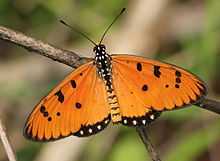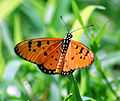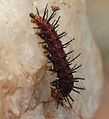Acraea terpsicore
| Tawny Coster | |
|---|---|
 | |
| Scientific classification | |
| Kingdom: | Animalia |
| Phylum: | Arthropoda |
| Class: | Insecta |
| Order: | Lepidoptera |
| Family: | Nymphalidae |
| Tribe: | Acraeini |
| Genus: | Acraea |
| Species: | A. terpsicore |
| Binomial name | |
| Acraea terpsicore (Linnaeus, 1758) | |
| Synonyms | |
|
Acraea violae (Fabricius, 1793) | |
The Tawny Coster (Acraea terpsicore[1]) is a small leathery winged butterfly which is common in grassland and scrub habitats. It belongs to the Nymphalidae or brush-footed butterfly family. It has a weak fluttery flight. It is avoided by most insect predators. This species and the Yellow Coster Acraea issoria are the only two Indian representatives of the predominantly African tribe Acraeini.
Description
_mating_in_Narshapur%2C_AP_W_IMG_0914.jpg)
Male
Upperside tawny. Fore wing: a transverse black spot in cell, and another irregular, oblique and broader at the disco-cellulars ; a discal series of spots in interspaces 1, 3, 4, 5, 6 and 10, and the apex and termen black. The upper four spots of the discal series inclined obliquely outwards, the lower two obliquely inwards ; the black edging to apex and termen narrowing posteriorly, but with slender linear-projections inwards in the interspaces. Hind wing: a basal series of four or five black spots with a similar spot beyond in middle of cell and a subcostal black spot above it, followed by a discal series of obscure blackish spots and a minute postdiscal black dot in interspaces 4 and 6 respectively ; finally, a broad black terminal band medially traversed by a series of small spots of the ground-colour. Most of the macular black markings are obscure, being only the spots on the underside seen by the transparency of the wing-membrane ; the inner edge of the black terminal band crenulate.
Underside: ground-colour ochraceous yellow or a paler tawny yellow. Fore wing paling to whitish on the apex, with the black markings as on the upper side but somewhat blurred and diffuse. Hind wing: the black spots and black terminal band as on the upperside, but the spots more clearly defined, none obscure; the series of spots traversing the black terminal margin very much larger and white- not tawny ; the base of the wing black, separated from the basal transverse series of black spots by two or three large whitish spots. Antennae black, head and thorax black spotted with ochraceous and white ; Abdomen anteriorly black, posteriorly ochraceous yellow with narrow transverse black lines; beneath, the palpi, thorax and abdomen ochraceous, the thorax spotted with ochraceous, the abdomen with a longitudinal line of black at base.
Female
Similar to that of the male. Upperside: ground-colour duller; the black spots on fore and hind wings larger, the upper discal spots often coalescing and forming an irregular oblique short band; the black edging to apex and termen on the fore wing and the black terminal band on the hind wing proportionately broader, the spots traversing the latter larger and whitish.
Underside: ground-colour much paler and duller, markings as on the upperside and, as in the male, the spots on the hind wing better defined than on the upperside, Antennae, bead, thorax and abdomen as in the male.[2]
Wing expanse of 53–64 mm.
Distribution
The butterfly is found in India and Sri Lanka. It is common all the year round and is equally at home in forest clearings and open country. Though mainly seen at low elevations it has been recorded at heights of up to 7,000 feet (2,100 m) in south India and sometimes in the North.
Habitat
This is a butterfly of the hills as well as the plains. It is plentiful in the pre-monsoon and monsoon period and becomes scarce later on.
Habits
The butterfly exudes an oily and smelly yellow liquid when handled and is unpalatable to birds and most insects. They are well protected and have a slow and weak flight, frequently visiting flowers and are easily netted. There are no mimics in India.
Life cycle
The butterfly breeds on plants of the family Loganiaceae and species of Passiflora many of which contain toxins that are sequestered by the caterpillars. They have also been noted to feed on the leaves of Hybanthus enneaspermus (Violaceae) in Bengal [3] and on Turnera ulmifolia (Turneraceae) in Maharashtra [4]
Lifecycle Gallery
-
Tawny Coster Female Laying eggs on its host plant
-
Tawny Coster Eggs
-
_cat_W_IMG_0578.jpg)
Caterpillar in Hyderabad, India.
-
_cat_W2_IMG_0578.jpg)
Caterpillar in Hyderabad, India.
-

Caterpillar
-
First stage of Pupation
-

Pupa
-
Pupa just before butterfly emerging
-

Adult
-

Acraea terpsicore
Larva
"Cylindrical, slender, with six longitudinal rows of fine branched spines; colour reddish brown with an oily gloss, much paler on the head, second and last segment; an unwholesome looking insect, doubtless protected like the butterfly." (Davidson & Aitken)[2]
Pupa
"Perpendicularly hung, long, slender, smooth; two lateral angles on the thorax; head quadrate; colour creamy white, with broad longitudinal bars of purplish-black spotted with orange." (Davidson & Aitken.)[2]
Different views & aspects
-

A watercolour based on a Sri Lankan specimen by Robert Templeton circa 1840
-
_mating_in_Narshapur%2C_AP_W_IMG_0912.jpg)
mating in Narsapur, Medak district, India.
-
_mating_in_Narshapur%2C_AP_W_IMG_0904.jpg)
mating in Narsapur, Medak district, India.
-
_on_Stachytarpheta_jamaicensis_(Porterweed)_in_Talakona_forest%2C_AP_W_IMG_8423.jpg)
on Stachytarpheta jamaicensis (Porterweed) in Talakona forest, in Chittoor District of Andhra Pradesh, India.
-
_in_Talakona_forest%2C_AP_W_IMG_8655.jpg)
in Talakona forest, in Chittoor District of Andhra Pradesh, India.
-
-_Male_on_Coat_buttons_(Tridax_procumbens)_in_Hyderabad%2C_AP_W_229.jpg)
Male on Coat buttons Tridax procumbens in Hyderabad, India.
-

Found in Changanacherry Kerala.
-
-_Male_in_Hyderabad%2C_AP_W_221.jpg)
Male in Hyderabad, India.
-

-

-

-

-

The tawny coster
-
Tawny Coster
Cited references
- ↑ Bernaud, D. and Pierre, J. (1997) Acraea terpsicore (Linné), problèmes de nomenclature et données biologiques (Lepidoptera, Nymphalidae). Bull. Soc. Ent. Fr. 102(5):405-412
- ↑ 2.0 2.1 2.2 Bingham, C. T. (1905) The Fauna of British India, Including Ceylon and Burma. Butterflies. Vol 1.
- ↑ Das RP, AB Roy, R Polley and G Saha (2010). "A new record of larval host plant of tawny coster Acraea violae (Fabricius)". J. Bombay Nat. Hist. Soc. 107 (1): 63.
- ↑ Khot, R., & Gaikwad, K. (2011). "An additional record of larval host plant of Tawny Coster Acraea violae (Fabricius 1775)". J. Bombay Nat. Hist. Soc. 108 (2): 140.
| Wikimedia Commons has media related to Acraea terpsicore. |
| Wikispecies has information related to: Acraea terpsicore |
Other references
- Bingham, C.T.(1905) The Fauna of British India, Including Ceylon and Burma. Butterflies. Volume 1.
- Wynter-Blyth, M.A., (1957) Butterflies of the Indian Region, Bombay Natural History Society, Mumbai, India.
- Kunte, Krushnamegh (2000) Butterflies of Peninsular India. Universities Press,Hyderabad. ISBN 81-7371-354-5
See also
External links
- Images representing Acraea violae at Bold.
- Die Gross-Schmetterlinge der Erde 13: Die Afrikanischen Tagfalter. Plate XIII 56 a
- Sri Lanka Wild Life Information Database
- http://www.srilankaninsects.net/Butterflies/Nymphlidae/TawnyCoster/TawnyCoster.htm
_at_Sindhrot_near_Vadodara%2C_Gujrat_Pix_042.jpg)






_in_Narshapur%2C_AP_W_IMG_0810.jpg)




